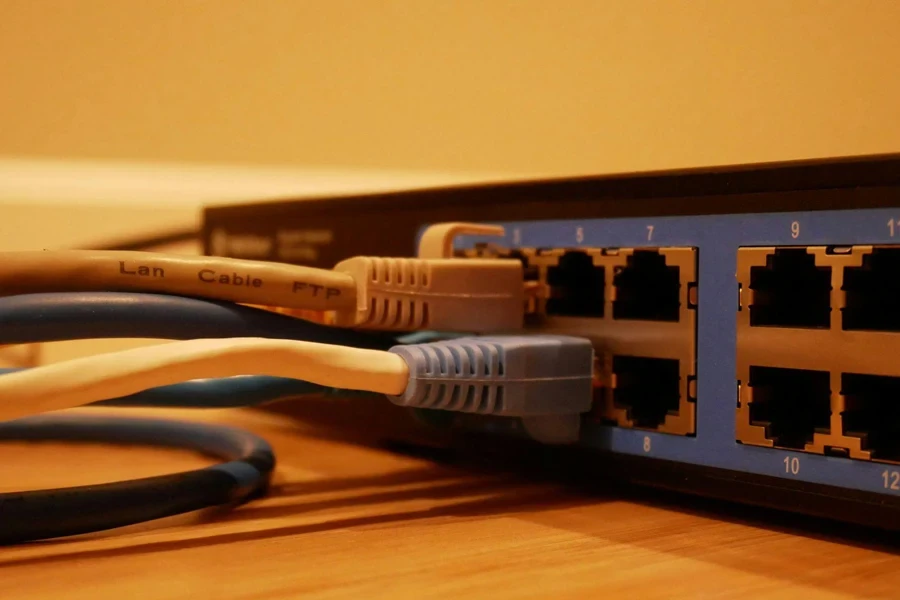Table of Contents
● Introduction
● Market overview
● Different types of routers and their features
● Things to consider when selecting routers
● Conclusion
Introduction
In an era dominated by digital interactions, the selection of routers is crucial, representing a strategic balance between digital connectivity demands and operational needs. As technological innovation advances the networking domain, the market offers a variety of routers, each with capabilities tailored to specific business scenarios. From dual-band routers that facilitate high-speed access to mesh systems that provide extensive coverage, the range of router technology is extensive and complex. This guide provides a comprehensive overview of router technologies, equipping enterprises with the necessary insights to make informed decisions that optimize their digital operations.

Market overview
The trajectory of the router market is characterized by a notable Compound Annual Growth Rate (CAGR), which is set to redefine industry standards. As digital connectivity becomes more integral to business operations, the demand for advanced networking solutions is driving significant market expansion. A report by TechNavio Research indicates a projected CAGR of 7.45% over the next five years, supporting the sector’s dynamic growth, driven by the need for sophisticated networking solutions. The increasing demand underscores the market’s move towards high-quality sound, enhanced comfort, and innovative features such as active noise cancellation and wireless integration.
Continuing on this upward trajectory, the router market’s evolution is tightly coupled with relentless technological innovation and the advent of novel product introductions. Industry frontrunners are at the vanguard, expanding their portfolios and incorporating state-of-the-art technologies to solidify their presence. Such strategic advancements, aimed at refining sound quality, enhancing user comfort, and ensuring seamless device compatibility, cater to a technologically adept consumer base. A forecast by Future Market Insights corroborates this trend, anticipating the market’s valuation to escalate from USD 27.04 billion to a staggering USD 40.92 billion by the end of the forecast period. This anticipated growth not only mirrors the sector’s swift progression but also underscores the escalating importance of routers in today’s digital ecosystem.
Different types of routers and their features

Dual-band routers: the versatile performers
Dual-band routers are recognized as versatile solutions capable of managing the demands of a modern, device-heavy environment. By offering two distinct frequency bands—2.4GHz for broader coverage at slower speeds and 5GHz for faster speeds over shorter distances—these routers adeptly handle network congestion. This capability allows for simultaneous high-definition video streaming and social media browsing across different devices. For example, while one department might engage in data-intensive online activities in one office, another can conduct a video conference in a separate location, all supported efficiently by the dual-band router’s ability to balance and distribute network traffic.
Mesh network routers: the architects of extensive coverage
Mesh network routers are designed to provide robust Wi-Fi coverage over large spaces, effectively eliminating dead zones. This system utilizes multiple router-like nodes distributed throughout the area, creating a single, unified Wi-Fi network. Unlike traditional routers that may struggle to deliver signal strength to remote corners of a building, mesh routers ensure consistent and reliable connectivity. They are particularly advantageous in extensive office spaces where maintaining consistent coverage is crucial.
Single-band routers: the economical choice
For organizations with straightforward internet needs and a limited number of devices, single-band routers provide an economical and effective solution. Operating solely on the 2.4GHz band, these routers are well-suited for basic office tasks such as web browsing, email management, and accessing company social media accounts. Their simplicity and affordability make them an optimal choice for small businesses or departments that require internet access in a constrained space without the need for extensive bandwidth.
Tri-band routers: masters of high-traffic management
Tri-band routers enhance connectivity by providing three separate frequency bands (one 2.4GHz and two 5GHz), accommodating a large number of devices without compromising performance. This type is suitable for environments such as tech-focused offices or departments where multiple devices operate simultaneously—streaming, gaming, video conferencing, and more. By allocating a 5GHz band to high-demand activities, tri-band routers maintain the clarity and continuity of video calls, ensuring that critical communications are not interrupted by other bandwidth-intensive tasks.
Wi-Fi 6 routers: pioneers of the future
Wi-Fi 6 routers embody the forefront of wireless technology, tailored to satisfy the bandwidth needs of modern connected enterprises. With capabilities for enhanced capacity, efficiency, and speed, these routers are engineered to support the Internet of Things (IoT) ecosystem, from advanced industrial sensors and smart building controls to security systems and efficient lighting solutions. They perform optimally in environments where multiple devices require simultaneous internet access, optimizing data allocation and minimizing latency. This technology facilitates a scenario in which enterprise devices operate efficiently, software updates are streamlined, and all online functions are executed without delays, enabled by the advancements of Wi-Fi 6 technology.
In the quest for the optimal router, understanding the nuances of each type is essential. From the balanced performance of dual-band routers and the expansive coverage offered by mesh systems to the cost-effectiveness of single-band options, the high-capacity support of tri-band models, and the future-ready capabilities of Wi-Fi 6 routers, there is a solution tailored to every networking challenge. By considering these options and their applications, enterprises can make informed decisions that align with their specific requirements, ensuring a robust and seamless digital experience in any environment.
Things to consider when selecting routers
Selecting the ideal router for an office involves more than choosing a device from a catalog; it requires making an informed decision that aligns with specific business needs. Understanding the various factors that should influence this choice is crucial. This section explores these considerations, providing real-world examples to assist in the decision-making process.

Network size and coverage area
The extent of the area to cover with Wi-Fi is a primary consideration. For compact office spaces, a conventional router may suffice, efficiently delivering Wi-Fi to every corner. However, for larger spaces or multi-story buildings, where signals must traverse walls and floors, a mesh system becomes essential. In scenarios involving expansive corporate environments, a mesh system, with its satellite nodes placed strategically throughout the building, ensures strong Wi-Fi coverage in every room, effectively eliminating dead zones.
Device compatibility
In today’s interconnected world, ensuring router compatibility with all devices is crucial. Modern routers generally support the latest Wi-Fi standards, but confirming this alignment is essential. For example, if a company has recently invested in a smart office system that operates on Wi-Fi 6, selecting a router that supports this standard is necessary to fully leverage the capabilities of the devices. This compatibility ensures that smart doorbells, thermostats, and security cameras function seamlessly, enhancing operational efficiency and connectivity.
Security features
With the increasing sophistication of cyber threats, the security features of routers assume critical importance. Choosing a router that incorporates advanced encryption standards and the ability to set up a secure guest network can protect data from unauthorized access. For instance, consider a small business handling sensitive client information; a router equipped with robust security protocols can serve as the first line of defense against potential breaches, safeguarding both the business’s and clients’ data.
Speed requirements
The speed a router can handle is another critical factor. It involves matching the router’s capabilities with the speed of the internet plan. For environments heavy on streaming 4K content, online gaming, or large file downloads, a router that can accommodate these demands is necessary. In an office where multiple devices simultaneously stream videos, engage in online gaming, and participate in video conferences, a router that can deliver high speeds to multiple devices at once without degradation in performance is essential.
User demand
Reflecting on the number of users and devices that will be accessing the network and their online activities is essential. An office environment with multiple users streaming video, engaging in online gaming, and attending virtual meetings will have different requirements than an environment where individuals primarily browse the web and check emails. In the former scenario, a router with significant bandwidth and the ability to prioritize traffic—ensuring that a video call for work isn’t interrupted by other high-bandwidth activities—is critical.
Conclusion
Navigating the complexities of the digital age requires selecting the right router—one that aligns precisely with organizational connectivity needs. The choice involves more than brand preferences, focusing on essential requirements for digital operations. From ensuring expansive coverage with mesh networks to leveraging the capabilities of Wi-Fi 6 for a future-ready network, the decision is nuanced and critical. Considerations such as network size, device compatibility, security importance, speed requirements, and the demands of an organizational environment are vital in this process. By addressing these key factors, organizations are not merely choosing a router; they are crafting a tailored digital environment. This decision is a cornerstone of daily digital interactions, enabling a seamless, efficient, and secure online experience that meets the demands of the modern business landscape.



